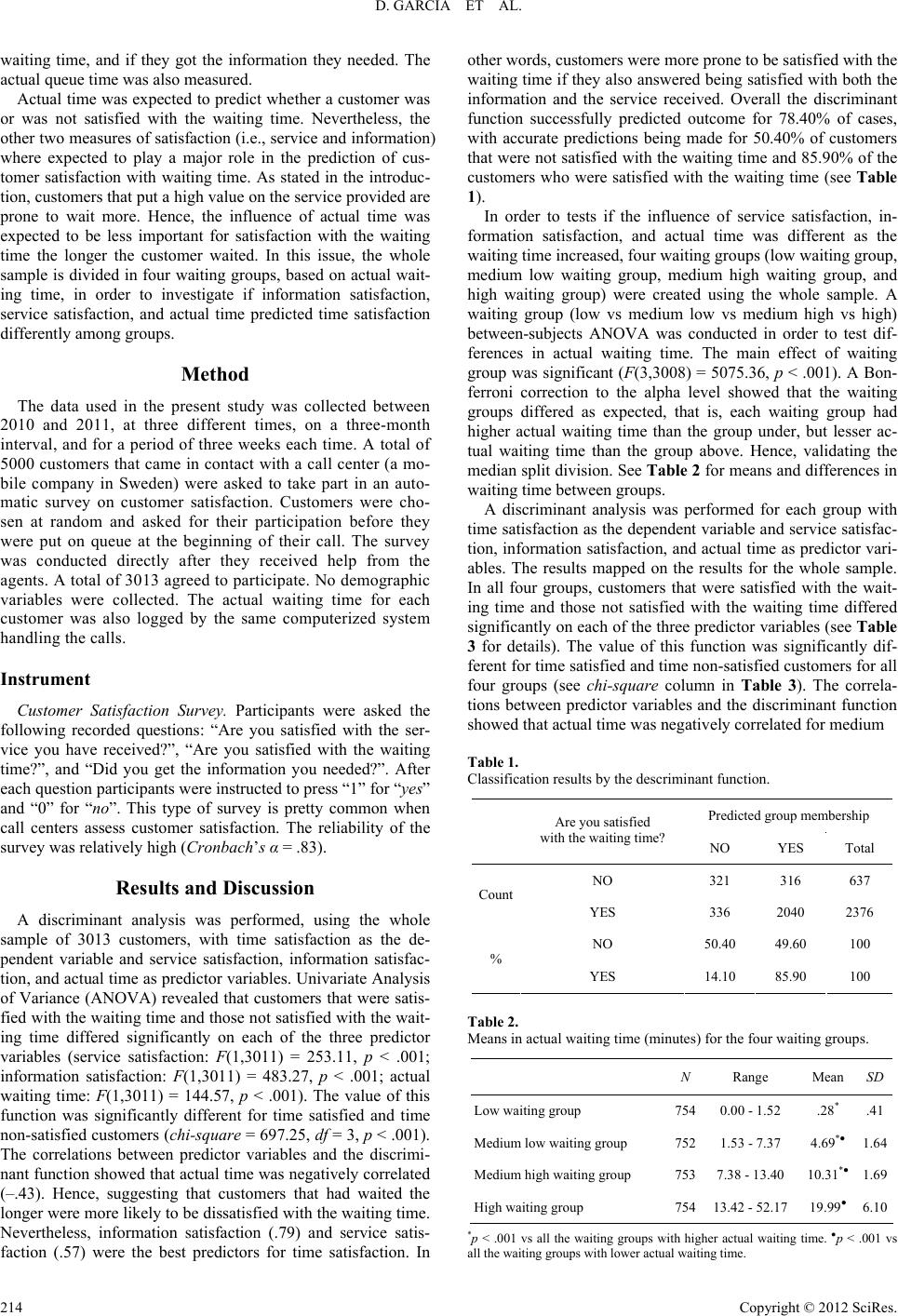
D. GARCIA ET AL.
waiting time, and if they got the information they needed. The
actual queue time was also measured.
Actual time was expected to predict whether a customer was
or was not satisfied with the waiting time. Nevertheless, the
other two measures of satisfaction (i.e., service and information)
where expected to play a major role in the prediction of cus-
tomer satisfaction with waiting time. As stated in the introduc-
tion, customers that put a high value on the service provided are
prone to wait more. Hence, the influence of actual time was
expected to be less important for satisfaction with the waiting
time the longer the customer waited. In this issue, the whole
sample is divided in four waiting groups, based on actual wait-
ing time, in order to investigate if information satisfaction,
service satisfaction, and actual time predicted time satisfaction
differently among groups.
Method
The data used in the present study was collected between
2010 and 2011, at three different times, on a three-month
interval, and for a period of three weeks each time. A total of
5000 customers that came in contact with a call center (a mo-
bile company in Sweden) were asked to take part in an auto-
matic survey on customer satisfaction. Customers were cho-
sen at random and asked for their participation before they
were put on queue at the beginning of their call. The survey
was conducted directly after they received help from the
agents. A total of 3013 agreed to participate. No demographic
variables were collected. The actual waiting time for each
customer was also logged by the same computerized system
handling the calls.
Instrument
Customer Satisfaction Survey. Participants were asked the
following recorded questions: “Are you satisfied with the ser-
vice you have received?”, “Are you satisfied with the waiting
time?”, and “Did you get the information you needed?”. After
each question participants were instructed to press “1” for “yes”
and “0” for “no”. This type of survey is pretty common when
call centers assess customer satisfaction. The reliability of the
survey was relatively high (Cronbach’s α = .83).
Results and Discussion
A discriminant analysis was performed, using the whole
sample of 3013 customers, with time satisfaction as the de-
pendent variable and service satisfaction, information satisfac-
tion, and actual time as predictor variables. Univariate Analysis
of Variance (ANOVA) revealed that customers that were satis-
fied with the waiting time and those not satisfied with the wait-
ing time differed significantly on each of the three predictor
variables (service satisfaction: F(1,3011) = 253.11, p < .001;
information satisfaction: F(1,3011) = 483.27, p < .001; actual
waiting time: F(1,3011) = 144.57, p < .001). The value of this
function was significantly different for time satisfied and time
non-satisfied customers (chi-square = 697.25, df = 3, p < .001).
The correlations between predictor variables and the discrimi-
nant function showed that actual time was negatively correlated
(–.43). Hence, suggesting that customers that had waited the
longer were more likely to be dissatisfied with the waiting time.
Nevertheless, information satisfaction (.79) and service satis-
faction (.57) were the best predictors for time satisfaction. In
other words, customers were more prone to be satisfied with the
waiting time if they also answered being satisfied with both the
information and the service received. Overall the discriminant
function successfully predicted outcome for 78.40% of cases,
with accurate predictions being made for 50.40% of customers
that were not satisfied with the waiting time and 85.90% of the
customers who were satisfied with the waiting time (see Table
1).
In order to tests if the influence of service satisfaction, in-
formation satisfaction, and actual time was different as the
waiting time increased, four waiting groups (low waiting group,
medium low waiting group, medium high waiting group, and
high waiting group) were created using the whole sample. A
waiting group (low vs medium low vs medium high vs high)
between-subjects ANOVA was conducted in order to test dif-
ferences in actual waiting time. The main effect of waiting
group was significant (F(3,3008) = 5075.36, p < .001). A Bon-
ferroni correction to the alpha level showed that the waiting
groups differed as expected, that is, each waiting group had
higher actual waiting time than the group under, but lesser ac-
tual waiting time than the group above. Hence, validating the
median split division. See Table 2 for means and differences in
waiting time between groups.
A discriminant analysis was performed for each group with
time satisfaction as the dependent variable and service satisfac-
tion, information satisfaction, and actual time as predictor vari-
ables. The results mapped on the results for the whole sample.
In all four groups, customers that were satisfied with the wait-
ing time and those not satisfied with the waiting time differed
significantly on each of the three predictor variables (see Table
3 for details). The value of this function was significantly dif-
ferent for time satisfied and time non-satisfied customers for all
four groups (see chi-square column in Table 3). The correla-
tions between predictor variables and the discriminant function
showed that actual time was negatively correlated for medium
Table 1.
Classification results by the descriminant function.
Predicted group membership
Are you satisfied
with the waiting time? NO YES Total
NO 321 316 637
Count
YES 336 2040 2376
NO 50.40 49.60 100
%
YES 14.10 85.90 100
Table 2.
Means in actual waiting time (minutes) for the four waiting groups.
N Range MeanSD
Low waiting group 754 0.00 - 1.52 .28* .41
Medium low waiting group 752 1.53 - 7.37 4.69*●1.64
Medium high waiting group 753 7.38 - 13.40 10.31*●1.69
High waiting group 754 13.42 - 52.17 19.99●6.10
*p < .001 vs all the waiting groups with higher actual waiting time. ●p < .001 vs
ll the waiting groups with lower actual waiting time. a
Copyright © 2012 SciRes.
214